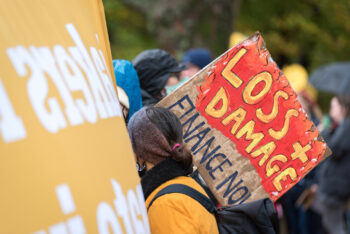
By Mattias Soderberg
The climate crisis is real. For me, and many others living in rich countries, the climate debate may seem like a theoretical challenge – something that may happen in the future. However, for most of the world’s population, the effects of climate change are already here and there is no time to waste.
The solutions are known, and to a large extent they already exist. We just need to implement them.
These solutions include renewable energy, tree planting, irrigation systems, cooling facilities, weather forecasts, insurance and a lot more. There are many good solutions which could help people, communities, and countries, if only the right investments were made.
So why hasn’t it been done already?
There are likely many good reasons, but a root challenge is the lack of funding. The lack of official climate finance, as well as financial flows of both private and public funds through trade, investments, and other transactions generates a big shortfall.
If the scientific predictions about the future are true (and they usually are) we have no other option than finding and mobilising the necessary funds. This is the background to the ongoing UN climate negations in Bonn, where parties are currently discussing future climate finance.
Three recommendations
I have three recommendations to the negotiators. First, make sure that the talks about finance are based on need as concluded by science. The current goal for climate finance, that rich countries annually should mobilize 100 bn USD, is not based on science. It is a political goal which was easy to communicate. But the climate crisis cannot be solved through messages which are easy to communicate. Investments must be made, and the money must be found.
My second recommendation is therefore to make sure adequate funds are mobilised. This is easy to say and more difficult to achieve. To begin with, investments in fossil fuels and solutions which contribute to global warming should end. The money should instead be invested in the solutions we need. Then, solutions which could be funded through markets should be promoted through trade and investment. In the UN climate talks these are referred to as financial flows, and they must contribute to the transition towards green and resilient development.
However, not all solutions can be funded through markets. Actually, a big portion of the most important solutions, including adaptation and efforts to address climate-induced loss and damage, will only be realized if grants are available. Currently, this is included in the official climate finance that developed countries commit to delivering every year.
Grants can be mobilized by rich countries through their annual national budgets. These funds must be drastically scaled up so that rich countries can increase their grant-based support to developing countries. However, considering the huge need for funds I am afraid these budget allocations, even if they are increased, will not be enough.
Which is why my last recommendation is to explore new and innovative ways to mobilise additional support. This may sound like a fantasy, but when the UN called for submissions on climate finance earlier this year, several parties proposed considering innovative finance solutions. Some years back there was even a high-level process within the UN climate talks to identify innovative ways to mobilise climate finance. That process delivered a report but was not followed by concrete agreements. As several parties have started to talk about innovative finance again, I believe the time is right to try.
I therefore hope that parties again will look for ways to scale up climate finance. We have the solutions, but we lack the money.
Without climate finance there is no climate action.
Mattias Soderberg is co-chair of the ACT Alliance climate justice group.